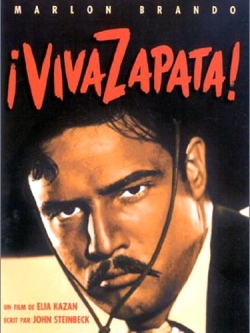Zapata. (original) (raw)
| by Maggie Van Ostrand |  |
|---|
John Steinbeck wrote it, Elia Kazan directed it, Marlon Brandostarred in it: Viva Zapata! But how close did these great artists come to the real thing? The answer lay in a telling 1916 interview by reporter Guillermo Ojara, sent by his paper, El Democrata of Mexico City, to interview Zapata himself. Here, greatly edited for space, are bits of that interview:
More than ever seeming the creature of ill omen which he has been to Mexico, the bandit leader, almost six feet in height and thin to the point of slenderness, stared out into the darkness, the blackness of his charro suit accentuated by the light which flowed around him. Dressed simply in a plain black suit, but with large diamonds on both hands, and a heavy gold watch chain running across his breast, his belt filled with cartridges and an automatic pistol slung at either hip, Zapata turned toward me the unexpressive face of an Indian of about 50 years of age, relieved by remarkably penetrating eyes. His head was small for his size, his face oval, and rather whiter than that of the average Guerrero Indian, thus betraying his share of Spanish blood, but his hands and feet were large, his mouth, under the heavy black moustache, loose and sensual, though the chin was firm, and the ears large but set close to the head.

When Zapata asked what the reporter wanted, Ojara presented written questions. Zapata pretended to read the letters, though he can neither read nor write, and then, complaining that the light was poor, called a short, stout fellow � to read them for him.
"So you want to know why I fight, and how strong my forces are?" Zapata asked.
�Yes," I replied. "Your career has attracted much attention in Mexicoand in the world outside, and I have come a long way to tell all these people just what you want and how you expect to get it."
"I am fighting for three things," replied Zapata, when coffee was brought: "first, to free all Mexicoof foreigners, especially the Spaniards and the Americans; second, to give back to the Indians their lands, taken from them by the Diaz Government, the Madero Government, and now by the Carranza Government; third, to give Mexicoan honest President, a ruler who will give justice to the 14,000,000 poor people as to the 2,000,000 so-called upper classes and the few hundred thousands of foreigners who have been allowed to drain the country of the great riches of the soil. I have fought for these things for nearly six years, and in the territory under my control every foreigner has been driven out or killed; every wealthy Mexican has been compelled to return his wealth to the Indians, to whom it rightfully belongs, and the land has been distributed to every peon who wanted a share of it.
"I am the man who should be President," Zapata continued. "Diaz, de la Barra, Huerta, Carranza, and Villa have tried to rule the country, along with half a dozen others, and all have failed. When I was in control in Mexico City I maintained better and more honest government than any of them. Thus I have proved that I am best fitted to rule the country."
"Do you plan to seize the Presidency?" I asked.
"That is something I do not care to disclose," Zapata answered.
"But if you become President what do you plan to do?" I persisted.
"The first thing will be to drive all the foreigners from Mexico. All of them have done Mexicomuch harm but the first ones to go will be the Americans. Then I will destroy all the railroads, so that they cannot come back. Before we had railroads we had few foreigners, especially few Americans, in Mexicoand we were happy. If we had no railroads now we should have no foreigners, and we should have peace and happiness again. Mexicocan produce everything she needs; therefore we do not need any foreign trade. Outside commerce always has been for the profit of the foreigners and not to the gain of us Mexicans, so why should we allow it?"
"But what if the foreigners, especially the Americans, should demand that you open your ports to their trade, as they once did to the Government of Japan?" I asked.
"When?" Zapata questioned, and, without waiting for a reply, went on:
"The United States could not compel the great Japan to do anything. Once the United States invaded Mexico, and I have heard that the Mexicans of that day drove them out with fearful slaughter. What we did once we can do again, and if the Americans come into Mexicowe will drive them clear beyond Texas, and maybe take that away from them."
Facts not in �Viva Zapata!� have come to light: The real Zapata commanded vast sums of money from those in power, as much as $1,500,000 pesos every ten days, although, as he said himself, �The poor people bring me food, the Indians give me men and horses, and I have taken much money from the rich whom I have killed or driven from the country.�

Brando�s Zapata rode a white stallion, while the real Zapata rode a �huge black horse.� Brando�s Zapata married Howard Hughes� wife, Jean Peters, while the real Zapata �talked of his triumphs with women, largely made by force of arms��
At least Brando resembled the real Zapata, unlike the studio�s original choice for the part: Tyrone Power.